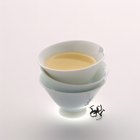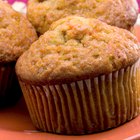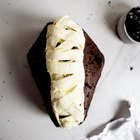
Few dessert lovers can resist making room for some whipped cream on their plate. Whether it's incorporated into a dessert as filling or added after the fact as a garnish, whipped cream adds a welcome richness and moisture to almost anything sweet. However, its versatility does have some limitations. One of the most important is that it quickly begins to deflate at room temperature, shrinking and losing its shape. Whipping vanilla pudding into the cream is one way to improve its durability.
Why Pudding Works
Traditional cooked puddings relied on heat to bring out the thickening power of eggs or flour, or sometimes both. These ingredients were heated with the dessert's cream and sugar, until it reached the correct thickness. Instant puddings eliminate the time and attention needed to cook and cool a traditional pudding, instead relying on chemical thickening agents to simulate the creamy texture of a conventional pudding. Most use ingredients that attract the milk's casein proteins to its calcium, creating a web of molecular bonds that holds the liquid in place. Some also use gums and emulsifiers to improve the texture of the finished pudding.
Whipped Cream With Pudding
Instant puddings are designed to dissolve easily in milk, but are less obliging with thick whipping cream. It's best to whisk the pudding into a small portion of your cream, dissolving most of the powdery crystals, and then add that to your cream when it's partially whipped. Continue whipping the cream until it forms a sturdy peak when you lift out the whisk or beater. The pudding contains a relatively high level of sugar and vanilla flavoring, so usually it isn't necessary to add any more before whipping the cream.
Using Your Stabilized Cream
The cream is ready to use as soon as it's whipped, but you can refrigerate it for later use if you prefer. The pudding will continue to set and stiffen the cream during this time. If you plan to use the whipped cream for decorating, it's best to fill your pastry bag as soon as the cream is ready and pipe the decorations immediately. After sitting, the cream might become too stiff to make decorative accents with clean, attractive edges. If you're using the cream as a filling or simply spooning it onto desserts, this is less important.
Some Alternatives
Vanilla pudding powder is easy to use as a stabilizer, but it has a few flaws. It gives a distinctive hue to the cream, yellowing it from its naturally white color. It also uses a relatively low grade of vanilla flavoring, much less appealing than real vanilla. Bakery supply stores sell stabilizing powders for whipped cream, usually derived from natural gums. They're added to the cream before whipping, making the foam more durable without affecting its flavor and color. An alternative method is to dissolve unflavored gelatin and whisk it into the whipped cream. This provides a long-lasting foam, again without altering its flavor or color.
Related Articles
What Do Bakeries Use in Their Whipped ...

How to Make Whipped Frosting Without ...

Tapioca Flour Vs. Quick Cooking Tapioca
A Substitute for Meringue

Can You Make Homemade Whipped Cream ...

Substitute for Vanilla Custard Powder

How to Fix Grainy Whipped Ganache

How to Harden Up Whipped Cream
How Can I Prepare Whipping Cream Ahead ...

What Does Stabilizing Frosting Mean?

How to Make Scalded Cream

How to Make Creme Brulee Without a Torch

Can I Thicken Ganache With Powdered ...
Cream vs. Creamer

Why Is My Pastry Cream Hardened?

Substitute for Manioc Starch

What Can You Use Instead of Powered ...

How to Make a Mummy on a Coffin Cake

How to Use Gelatin to Thicken Frosting

Substitute for Heavy Whipping Cream in ...
References
- The Professional Pastry Chef; Bo Friberg
- Fine Cooking: Soy Milk vs. Instant Pudding -- Who Will Win?
- The Kitchn: Long Lasting Whipped Cream -- Which Method Works Best?
Writer Bio
Fred Decker is a trained chef and prolific freelance writer. In previous careers, he sold insurance and mutual funds, and was a longtime retailer. He was educated at Memorial University of Newfoundland and the Northern Alberta Institute of Technology. His articles have appeared on numerous home and garden sites including GoneOutdoors, TheNest and eHow.
Photo Credits
Photodisc/Photodisc/Getty Images